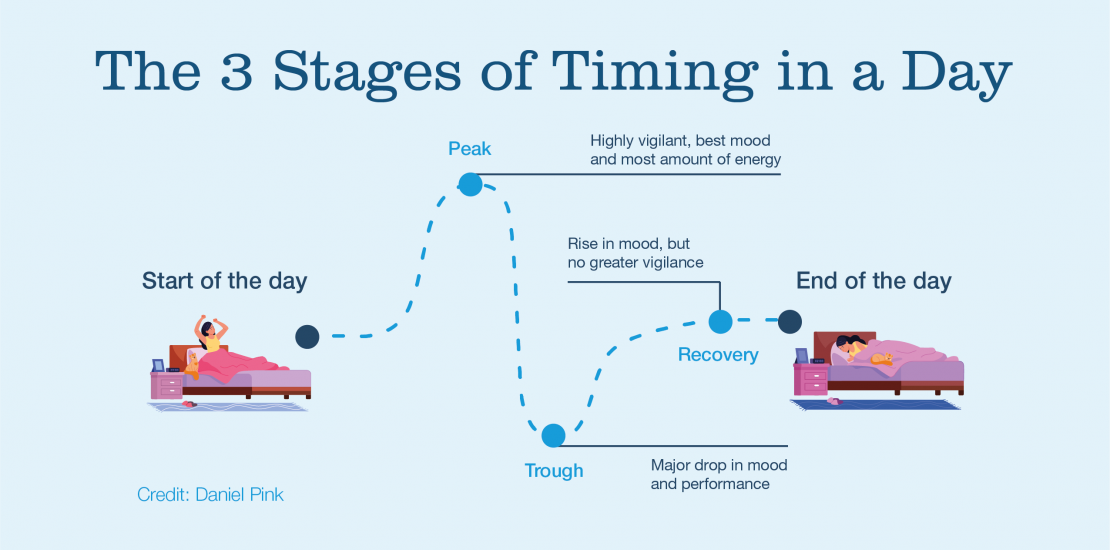- April 11, 2023

With everyone agreeing that ‘timing is everything’, wouldn’t it be useful to learn more about timing itself? For us, the answer was a resounding yes!
Daniel Pink’s book “When: The Scientific Secrets of Perfect Timing” explains how our cognitive abilities follow a predictable pattern over the course of a day, with the highest performance occurring during certain periods and lower performance during others. It’s really interesting to learn about how individual body patterns work throughout the day, and how we’re able to recognise which tasks benefit that pattern.
Before we cover the three stages of the day, it’s important to note which chronotype you are. A chronotype is just your bodies sense of when it wants to be awake, or asleep. Pink sets people into three types: Larks, Owls and Third Birds. The split is simple:
Larks: Like to be up and working early (14% of the population).
Owls: Like to be up and working late (21% of the population).
Third Birds: Like to be somewhere in between (65% of the population).
Here’s a quick test to see what type you are. You can also find a variety of online questionnaires for a more detailed review.
- Figure out the midpoint of your sleep cycle on a day when you don’t have to wake up to an alarm clock. This will most likely be on your days off or during the weekend.
- If your midpoint of sleep is 3:30 a.m. or earlier, you’re probably a lark.
- If your midpoint of sleep is 5:30 a.m. or later, you’re probably an owl.
- If your midpoint is somewhere in between, you’re probably a third bird.
Now you know your body-clock a bit more, there are three stages of timing throughout the day that most people follow. Depending on your chronotype, the ‘peak’ can be moved earlier or later on in the day.
Let’s look at what these stages are in more detail, and how the pattern can be applied to daily tasks. It can be applied in your personal life, at work, or even can be a discussion to have with a project team to make sure everyone is on a similar page.
The peak: This is the first stage, when we experience a peak in both our mood and vigilance. This stage typically occurs in the morning, usually between 9 am and noon. During this stage, we generally have better focus, better problem solving, and can make important decisions.
The trough: This is the second stage, when both our mood and vigilance drop. This stage typically occurs in the early afternoon, usually between 1 pm and 3 pm, and is often associated with a decrease in focus, energy, and productivity. You know when you are struggling to stay awake after a nice lunch – that’s it. Try to do admin tasks, replying to emails or doing your expenses.
The recovery: This is the third and final stage, when our mood increases, but vigilance remains the same. This stage typically occurs in the late afternoon or early evening, usually between 3 pm and 6 pm, and is often associated with higher levels of creativity and more innovative thinking. Look to generate new ideas or brainstorm problems with colleagues.
Understanding these patterns can make a huge difference to your performance, and that of your teams. Try to test out changing your daily plans to align with this new knowledge and reap the rewards.
